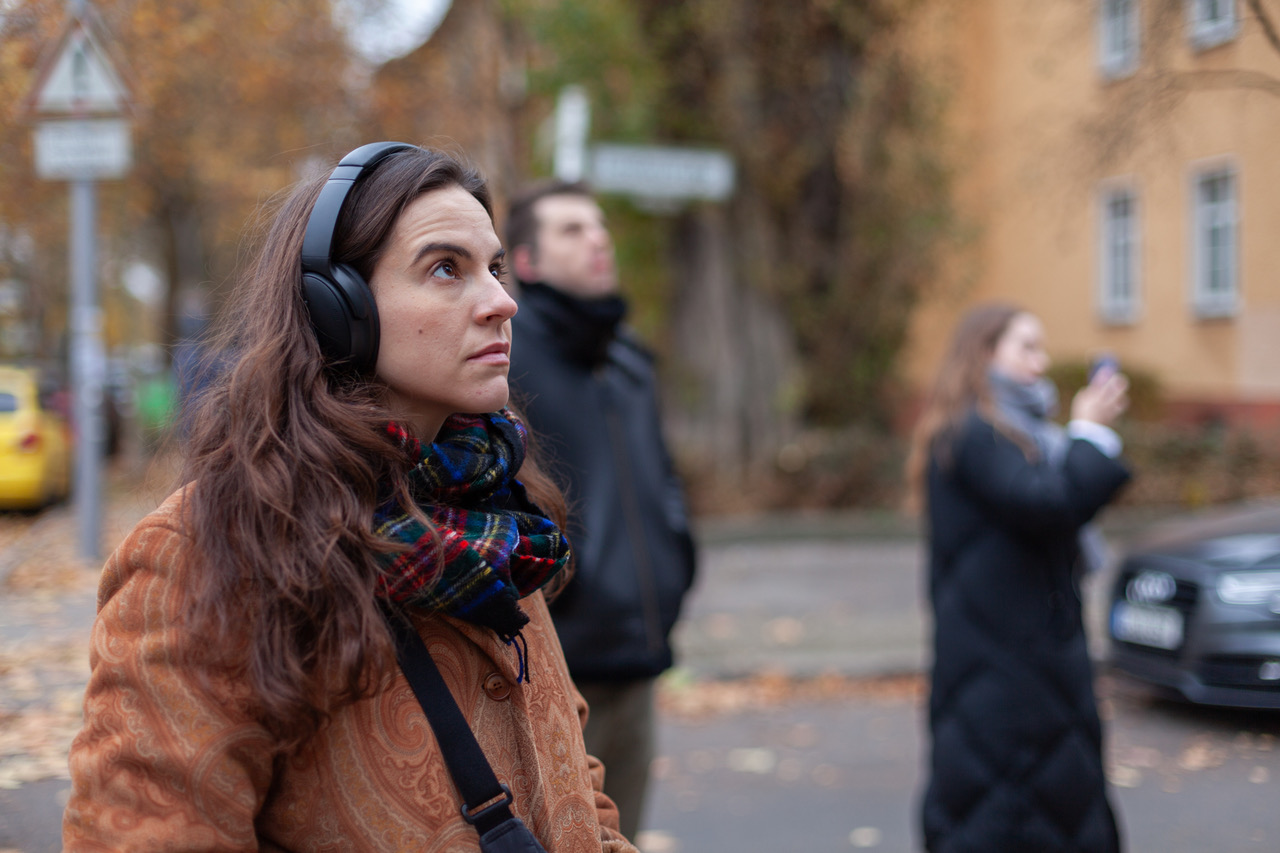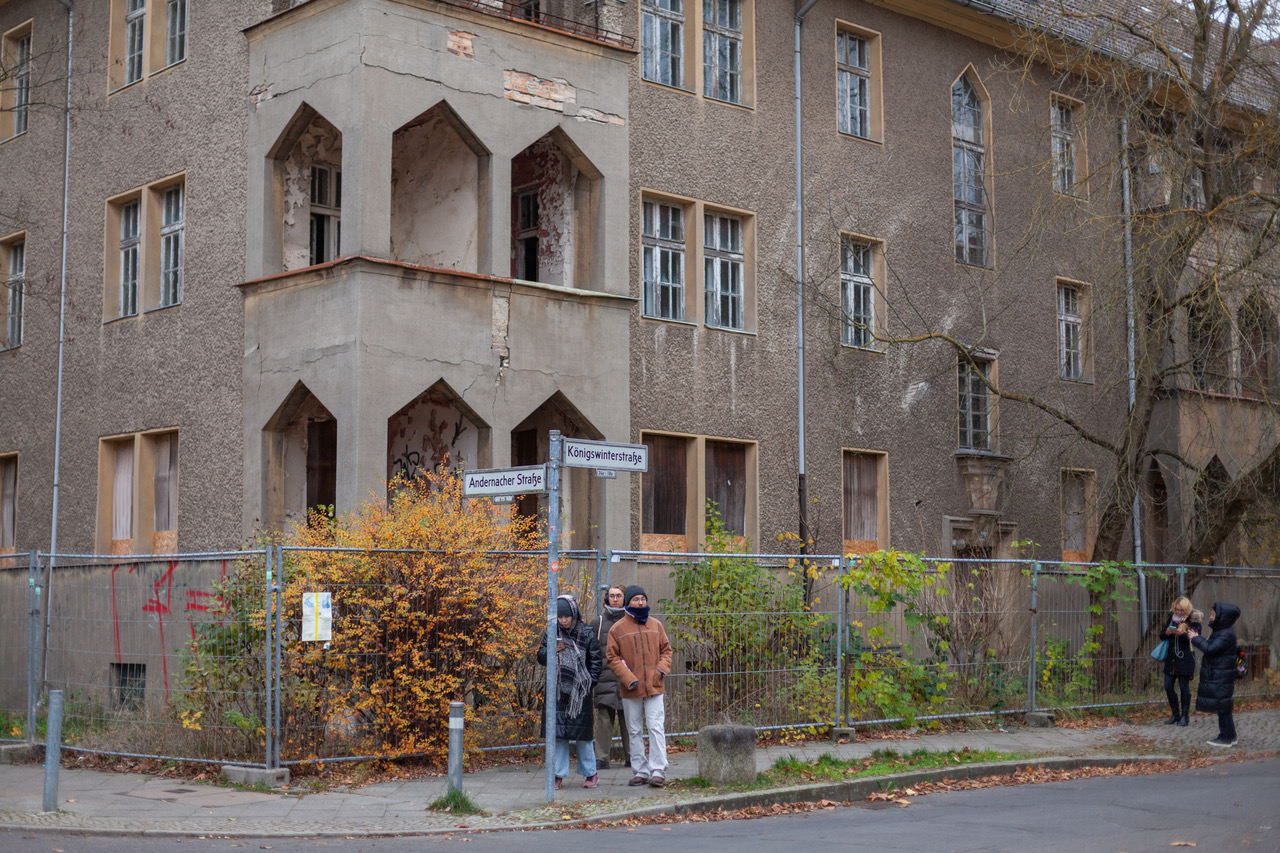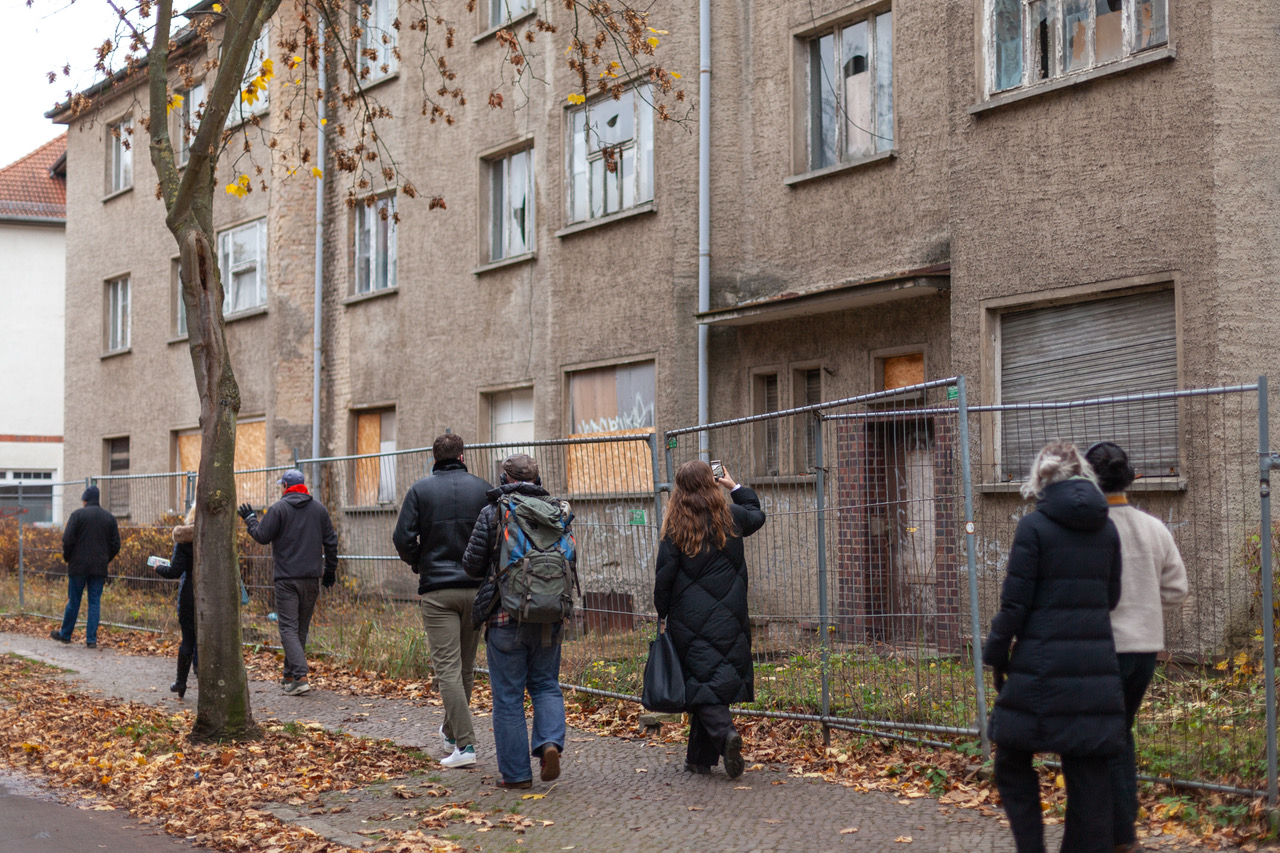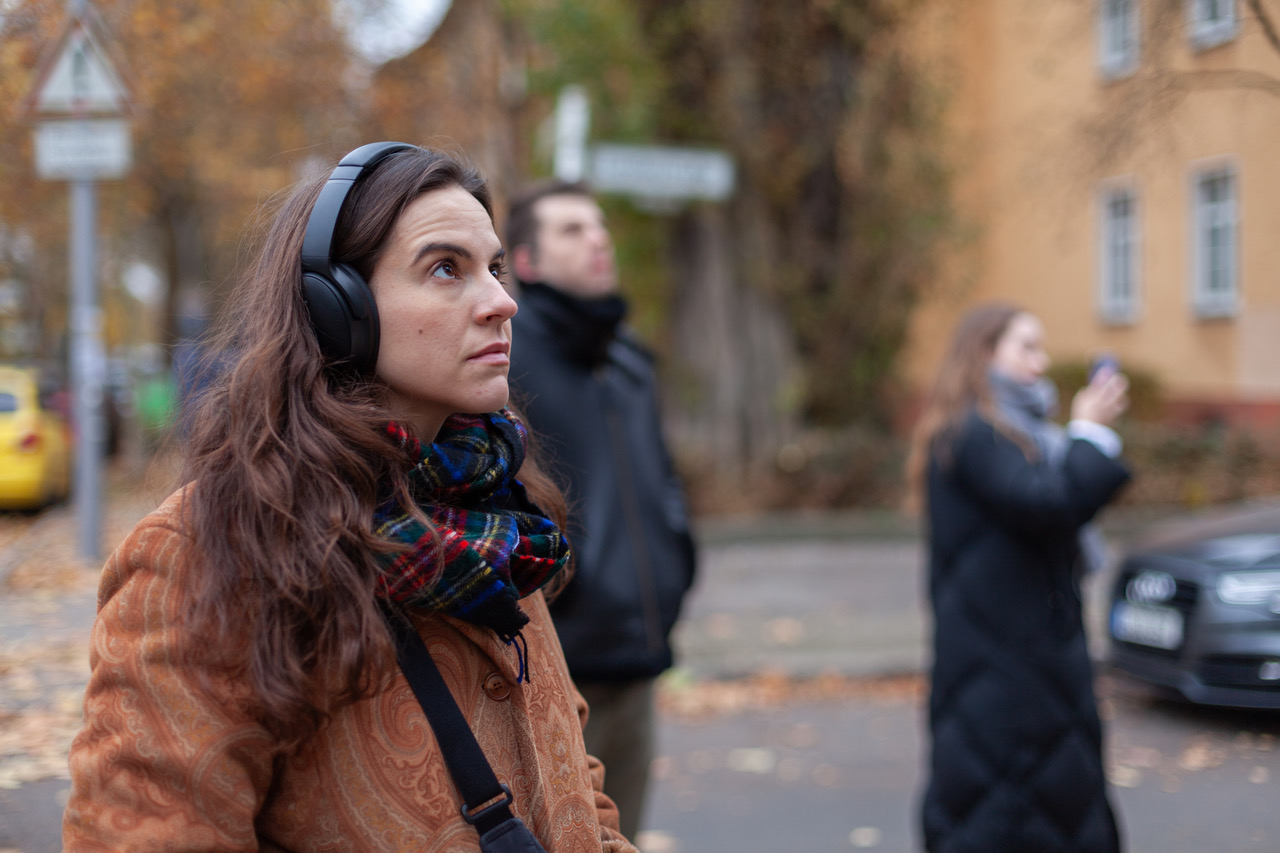Audiowalk "and let no one be forgotten"

Photo: Katya Romanova
Königswinterstr. x Andernacher Str.
Breaking in
Andernacherstr./Königswinterstr.
Research + Interviews
Andernacherstr./Königswinterstr.
and
The Walk to Ehrenfelsstraße/Loreleystraße
At this tour stop we continue with the conversations between Caro and Marianne as well as interviews with Hannah, Marianne Streisand and Wolfgang Voigtländer.
Breaking in
Location: Andernacherstr./Königswinterstr.
CARO:
I think this is them - the houses.
MARIANNE:
Hmm they’re smaller than I remember.
CARO:
The bins are full of branches. See? Does that mean someone does some sort of upkeep?
MARIANNE:
Well, some of the windows seem freshly boarded, so I suppose someone takes care of it.
CARO:
Look at the paint peeling off. Over there in the balconies. It kind of reminds me of flaking ash.
They’re beautiful.
MARIANNE:
Beautiful?
CARO:
I don’t know. Kind of. They feel so alive with the past. I wonder what stories they hold.
MARIANNE:
Stories, yes. But more like memories trapped within the walls.
CARO:
Do you think anyone cares about them anymore?
MARIANNE:
They seem very otherworldly, don’t they? Stuck in time.
CARO:
(Pensive) What’s that saying? “The past is never dead; it’s not even past.”
MARIANNE:
Let’s go in.
CARO:
WHAT?
MARIANNE:
Come on.
CARO:
Oma, no.
MARIANNE:
Why not? I know these houses. I want to see inside.
CARO:
It’s illegal.
MARIANNE:
What’s gonna happen if we get caught, huh? They’re not going to punish an old woman.
CARO:
You’re not that old. And that’s not how the law works.
(The sound of Marianna moving closer or perhaps shaking the fence)
Oma!
MARIANNE:
Come on.
CARO:
(Gives a resigned sigh) How are we going to get in?
We could climb over the fence. The boards are just made of chipboard. Wouldn’t take much to break
them.
MARIANNE:
I can’t climb over that with my hip, look at me!
CARO:
Well, how do you suppose we get in?
MARIANNE:
Let’s go round the back.
CARO:
Ok.
MARIANNE:
I feel like a naughty child! (laughs)
CARO:
You are! I can’t believe we’re doing this. I’m telling mum this was your idea if we get caught.
MARIANNE:
There’s a lock.
CARO:
Yeah, a pretty pathetic one. We just need to break that part of the door.
MARIANNE:
Use that rock there.
CARO:
Alright.
(Sounds of them breaking the door.)
CARO:
Oh gosh, I don’t know if it’s safe to go up these stairs.
MARIANNE:
Come on, let’s at least go to the first floor.
CARO:
Which apartment did your ‘Russian lover’ live in?
MARIANNE:
I think it was the one on the right.
(They climb the stairs.)
Here! This is it.
CARO:
This is actually a very nice apartment (impressed). Much nicer than mine.
MARIANNE:
This was the living room, I think.
Through there was his bedroom. He shared it with his little brother.
CARO:
Can we get through?
MARIANNE:
The floorboards there don’t look like they’ll take much weight.
CARO:
Yeah, the hole in the floor is giving me a ‘no thank you’...
MARIANNE:
My younger self would never have believed this is what this room would eventuate to.
CARO:
Watch out for the shit over there. What animal do you think that is? MARIANNE:
Raccoons, probably.
CARO:
Look at this beautiful old furnace.
MARIANNE:
We had one just like it.
(Sounds of them walking around.)
MARIANNE:
It’s so… bare.
CARO:
What did his parents do?
MARIANNE:
I don’t know. His father was some sort of high-ranking soldier. We weren’t really concerned with our parents or politics or anything. And there was a language barrier. We just liked each other’s faces.
CARO:
So vain. (laughs)
MARIANNE:
I remember he once showed me this album - a beautiful book his father had made showing his military career. There were pictures of him in uniform decorated with cut-out paper flowers pasted around, and illustrations he had drawn. It seemed like a strangely artistic tradition for a soldier.
CARO:
Oh, I can see you both sitting here falling in love. Making plans together. Did you dream about the future?
MARIANNE:
I don’t know. We must have. I think we used to make jokes about running away together, but it was never serious. We didn’t really mean it.
CARO:
Were there things you wanted to do in your own life?
MARIANNE:
I remember really wanting to travel and feeling like that wasn’t possible. I longed for freedom. The freedom to travel. You couldn’t even travel to the Soviet Union, except in rare cases.
The lack of travel was really something that gnawed at me. And that feeling of being trapped. I felt trapped.
CARO:
(softly) How did it end? Was it a tragic heartbreak?
MARIANNE:
I honestly don’t remember. I think the novelty wore off. Or maybe it started to get harder to see each
other.
CARO:
Oh, Sacha Kazakov. Where are you now?
MARIANNE:
Very far from here.
CARO:
This house really is quite beautiful. I wish I was rich and could just buy it and renovate it all. Imagine
bringing this back to life! Right now it’s just… empty. It’s so wrong! It almost feels like it’s in mourning.
There’s a sort of grief in this room.
It feels a bit like a graveyard, doesn’t it? Not haunted, necessarily. Just… dead.
MARIANNE:
I want to go now.
CARO:
What?
MARIANNE:
Let’s go. There’s nothing here but forgotten memories and raccoon piss.
Roadside Picnic:
“How do you think it’s all going to end?” “What are you talking about?”
“The Visit. Zones, stalkers, military-industrial complexes—the whole stinking mess. How could it all
end?”
For a long time, Valentine stared at him through his opaque black lenses. Then he lit up a cigarette and
said, “For whom? Be more specific.” “Well, say, for humanity as a whole.”
“That depends on our luck,” said Valentine. “We now know that for humanity as a whole, the Visit has largely passed without a trace. For humanity everything passes without a trace. Of course, it’s possible thatbyrandomlypullingchestnutsoutofthisfire,we’lleventuallystumbleonsomethingthatwillmake life on Earth completely unbearable. That would be bad luck. But you have to admit, that’s a danger humanity has always faced.”
Research + Interviews
Location: Andernacherstr./Königswinterstr.
+ The Walk to Ehrenfelsstraße/Loreleystraße
Hannah Alongi:
What you are hearing is a recording from one of our onsite research days back in June, taken right here at the corner of Andernacherstr and Königswinterstr. Hello, my name is Hannah Alongi, and I’m one of the collaborating artists on this audio walk.
In the summer, we set up a mobile kiosk here on the pavement - a public forum we called the Kiosk of Memory - to invite passersby to share with us what they thought and knew about the houses. We also offered a program of talks and a neighbourhood walk led by local experts to provide historical insight into these houses and foster a space for exchange between neighbours.
Through this exchange, we began to recognize the houses not as relics from the past but instead current and topical. Many residents hoped the houses would one day be part of the community again; others were wary that intervention could threaten what’s left.
From the onset of this project, we hoped to speak to a former resident who was still living. But since the apartments were filled with military officers and their families from 1945 until they were left empty, it’s unlikely we’ll ever hear first-hand of life inside.
A turning point in our research was our discovery of telephone and address books featuring the names of people who once lived in the houses - of course from before the DDR, when the residents were not Soviet officers but ordinary, predominantly German, civilians. Documents cannot tell us a complete story but they do give us glimpses into the lives of people in the past. Although we only know their names, the years they lived here, and their occupations, we can begin to build narratives of who they were.
For one name, however, Rudolf Mandrella, no imagination is necessary. His story has been pieced together through extensive records. Here is some of what we know.
Mandrella was born in Auschwitz in 1902 and grew up in poverty. In 1923, as a penniless student, he moved to Berlin to study law, and after passing his exams became appointed a district judge in Köpenick, in 1933. Three years later, he moved into an apartment at Königwinterstraße 24.
Mandrella was completely opposed to the Nazi regime. To avoid being conscripted into the Wehrmacht, he volunteered for the navy - perhaps calculating his chances of engaging in close combat to be slim. In Stettin, where he was stationed, Mandrella met servicemen equally against the Nazis and the war. But their group was discovered. Mandrella was executed in the Brandenburg-Görden penitentiary on September 3rd, 1943. He is listed amongst the names of resistance figures and martyrs during the Nazi era on a memorial plaque in the crypt of St. Hedwig's Cathedral in Berlin-Mitte.
The portrait we paint will never be complete, but with the clues we do know, we can commemorate those whose names may been shouted down these hallways.
I invite you to join us in filling in the gaps.
It’s time to go. Follow Königswinterstraße in the direction leading away from the park. When you reach Ehrenfelsstraße, turn left. You’ll see the next set of empty houses right there on the right. As we go, I will read you some of the names we found - the names we know…
Frieda Knippel, Secretary, Andernacherstr 5a, 1943 Ernst Keppler, Salesman, Andernacherstr 5a, 1943 Günther Leibig, Doctor, Königswinterstr 24, 1935
Katharina Schmidt, Pensioner, Königswinterstr 24, 1937 Heinrich Erdner, Gardener, Andernacherstr. 5a, 1940 Else Siewfe, Housewife, Königswinterstr. 25, 1943
Erich Gromabla, Engineer, Andernachster 5a, 1933
Rudolf Mandrella, District Judge, Königswinterstr 24, 1937
Marianne Streisand:
So, my grandfather was Jewish and had a bookshop in West Berlin, an antik bookshop, where he specialized in scientific socialism back in the 1920s, and really great people, like Walter Benjamin for example, they bought from him, crazy, right?
Yes, my father and my aunt, the children of the two of them, they were so-called half-Jews, according to Nazi terminology.
Yes, and for them it was of course a real liberation when the Russians took Berlin, you can imagine that.
Wolfgang Voigtländer:
My father never spoke about the war. He was a soldier and I don't even know if he was a prisoner. I think he was in Norway or something. But he never spoke about it.
My name is Wolfgang Vogtländer, I was born on March 15th 1951 in Erfurt and then in 1963 or 1964 I moved to Karlshorst.
In Karlshorst I lived at Hentigstrasse 33, which is one street away from Krümelhardt-Gundelfinger, so it wasn't easy of course and at the beginning we didn't like leaving the area where you have friends and so on, but I didn't think it was that bad, well, of course I was the ‘Sachsenscheißer’, I don't know if you know this term, I came from Thüringen. And well, Thüringen and Sachsen is a whole other story. The dialect takes some getting used to and at the beginning I tried my best not to speak my dialect, of course that goes completely wrong. Well… and a common term back then was ‘Sachsenscheißer’.
Let's put it this way: you never saw Soviet soldiers alone anyway. They were in the barracks or wherever, but not in contact. Usually an officer would be out with one, two, three soldiers, organizing something or something.
That was OK,
But that was it. As I said, personal contact… that was not wanted.

Photo: Katya Romanova

Photo: Katya Romanova
Location

